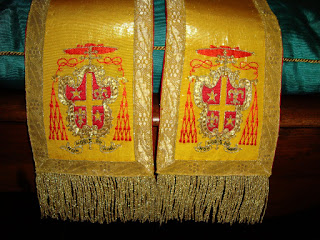Wednesday, August 3, 2016
OF MITRES AND MEN III
Today we shall take a look at the middling mitres: the auriphrygiate types. These are differenced from the precious mitres, essentially, in the lack of jewels - which renders them lighter in weight and thus more comfortable to wear for extended periods of time.
They are also sometimes called golden mitres, because in their simplest of forms, they are merely made of golden cloth without further ornamentation... well, maybe the arms of the owner embroidered on the infulae such as those pictured by JP Sonnen over at Orbis Catholicus that once belonged to Cardinal Siri (something we at Klave Centesca love being able to do for Bishops, Archbishops, Cardinals and Pope with quality like that of yesteryear! But made in the USA, today.)
The name of Auriphrygiata, though, comes from the fact that Phrygia was famous for its golden embroideries back in Roman times. These would have been of scrolling foliages or figural, and were highly priced - adorning the purple toga of the triumphant generals and later the robes of the imperial family. In time, the church was endowed with donations bearing these gold needleworks in the style of Phrygia, and eventually, herself began commissioning paraments and vestments with such ornamentation.
One of the earliest extant auriphrygiate mitres are those which depict the martyrdom of Saint Lawrence and Saint Thomas Becket:
These would have been used on the patronal feasts of the saints depicted, since for such occasions it was usual to have processions and long liturgies in which lighter mitres could be employed.
Toledo, according to its own traditions, still uses one for Requiems and other occasions (for which the Roman Rite only allows the Mitra Simplex in white) which depicts the crucifixion:
Mitres with whole scenes embroidered on them were once fairly common. France certainly has some of the most beautiful examples. This one, in the Musee de Cluny today, has scenes of the Nativity and is one of our favorite:
Others, rather than having whole scenes, show just the iconic representation of a Saint, Martyr, Virgin or Jesus himself - usually with their respective attributes. Here are some worthy of note:
Then, there are those that depict a cross, a dove or other symbols.
Lastly, as with the case of the precious mitres, we end up with the veritable gardens that became popular from the 1700s to the 1900s. This example, in polychrome flowers from Germany is quite striking:
Something else to note is that these "garden" mitres generally use a multitude of colors in their embroideries, while only gold is used in the Mitra Pretiosa for flowers and foliage - which need to better showcase the colored jewels sewn onto the fabric.
We hope you have enjoyed the small selection of embroidered mitres. We are currently working on a couple of mitres inspired by some of these seen here which will be put up for auction. Also, if you want something spectacular, you know how to reach us. From a simple coat of arms on the infulae to something more elaborate - we do love a challenge here at Klave Centesca!
As a sample, here's the mitre inspired by the beautiful rose window tracery at the Basilica of Our Lady in Guelph, Canada, that we embroidered with the arms of Bishop Ustrzycky as a gift from one of his parishioners, our friend Massimo Marcone:
And a monochromatic auriphrygiate version in the works, to be auctioned off once we finish putting it together:
Blessings to all!
Labels:
canada,
coat of arms,
ecclesiastical arms,
embroidered arms,
embroidery,
episcopal order,
gold embroidery,
guelph,
infuale,
jeweled mitre,
mitra auriphrygiata,
mitres,
toledo,
vestments,
western rites
Subscribe to:
Post Comments (Atom)























No comments:
Post a Comment